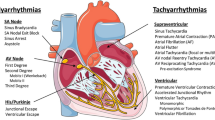Abstract
The cardiac action potential results from a dynamic balance between inward depolarising Na+ and Ca2+ currents and outward K+ repolarising currents. During a cardiac cycle, the resultant of repolarisation phase from all ventricular cells is represented by the QT interval of the surface ECG. Congenital long QT syndrome (LQTS) is characterised by polymorphic ventricular tachycardia sometimes with twisting QRS morphology (torsade de pointes) which, although usually self-limiting, can result in sudden cardiac death.
Acquired LQTS can be induced by a variety of drugs, including some non-sedative histamine H1 receptor antagonists (astemizole, terfenadine). The Committee for Proprietary Medicinal Products of the European Union has recently proposed studying the action potential in in vitro heart preparations as a preclinical test for predicting the propensity of noncardiovascular drugs to induce malignant QT prolongation in humans.
The effects of several histamine H1 receptor antagonists on the electrically evoked action potential have been evaluated in rabbit Purkinje fibres. In this preparation, astemizole (0.3 to 10 μ, mol/L) prolongs the duration of the action potential measured at the level where repolarisation is 90% complete (APD90). This effect is dependent on drug concentration, incubation time, pacing frequency and K+ or Mg2+ concentration. Astemizole also markedly depresses the rate of rise of the action potential (Vmax). Terfenadine showed qualitatively similar, but quantitatively smaller, effects in this model. The histamine H1 receptor antagonists cetirizine, ebastine, carebastine, loratadine and fexofenadine do not significantly affect APD90 at 1 μ, mol/L, but cetirizine and carebastine prolong it slightly at 10 μ, mol/L.
In conclusion, in rabbit Purkinje fibres, astemizole and terfenadine produce adverse electrophysiological effects at concentrations which may be achieved in the human myocardium in certain clinical situations. APD90 lengthening induced by carebastine and cetirizine is minor and occurs at concentrations that are very unlikely to be encountered clinically, since these drugs, in contrast to astemizole and terfenadine, do not accumulate in the myocardium.
Direct extrapolation of preclinical results to humans requires great caution, since malignant QT prolongations by terfenadine and astemizole are extremely rare clinical events. However, since prolongation of the QT interval often precedes the development of torsade de pointes, any significant delay in cardiac repolarisation produced by noncardiovascular drugs in preclinical, and particularly in clinical, studies should, in general, be considered to indicate a potential cardiac risk in humans. Its significance should subsequently be evaluated in appropriate studies in patients with conditions known to predispose to arrhythmias.
Similar content being viewed by others

References
Committee for Proprietary Medicinal Product. Points to consider: the assessment of the potential for QT interval prolongation by non-cardiovascular medicinal products. CPMP/986/96: 1997
Lindquist M, Edwards RJ. Risks of non-sedating antihistamines. Lancet 1997; 49: 1322
Woosley RL. Cardiac action of antihistamines. Ann Rev Toxicol 1996; 36: 233–52
Morganroth J, Brown AM, Critz S, et al. Variability of QTc interval: impact on defining drug effect and low frequency cardiac event. Am J Cardiol 1993; 72: 26B–31B
Katz AM. Selectivity and toxicity of antiarrhythmic drugs: molecular interactions with ion channels. Am J Med 1998; 104: 179–95
Sanguinetti MC, Keating MT. Role of delayed rectifier potassium channels in cardiac repolarization and arrhythmias. News Physiol Sci 1997; 12: 152–7
Morganroth J. Relations of QTc prolongation on the electrocardiogram to torsades de pointes: definition and mechanisms. Am J Cardiol 1993; 72: 10B–13B
Statters DB, Malik M, Ward D, et al. QT dispersion, problems of methodology and clinical significance. J Cardiovasc Electrophysiol 1994; 5: 372–685
Ackerman MJ, Clapham DE. Ion channels — basic science and clinical diseases. N Engl J Med 1997; 336: 1575–86
Priori SG, Barhanin J, Hauer RNU, et al. Genetic and molecular basis of cardiac arrhythmias. Impact on clinical management. Eur Heart J 1999; 20:174–95
Jongsma HJ. Sudden cardiac death. A matter of faulty ion channels. Curr Biol 1998; 8: R568–71
Roden DM, Lazzara R, Rosen M, et al. Multiple mechanisms in the long-QT syndrome current knowledge, gaps, and future directions. Circulation 1996; 94: 1996–2012
Roden DM. Current status of class III antiarrhythmic drug therapy. Am J Cardiol 1993; 72: 44B–49B
Hondeghen LM, Snyders DJ. Class III antiarrhythmic agents have a lot of potential but a long way to go. Circulation 1990; 81: 686–90
Zipes DP, Wellens HJJ. Sudden cardiac death. Circulation 1998; 98: 2334–51
Caron J, Adamantidis M, Bordet R, et al. Effets proarrythmiques des antihistaminiques H1. Lettre Pharmacol 1996; 10: 200–7
Adamantidis MM, Lacroix DL, Caron JF, et al. Electrophysiological and arrhythmogenic effects of the histamine type-l receptor antagonist astemizole on rabbit Purkinje fibers: clinical relevance. J Cardiovasc Pharmacol 1995; 26: 314–27
Pusieux FL, Adamantidis MM, Dumotier BM, et al. Cisapride-induced prolongation of cardiac action potential and early afterdepolarizations in rabbit Purkinje fibres. Br J Pharmacol 1996; 117: 1377–9
Michels M, Van Peer A, Woestenborghs R, et al. Pharmacokinetics and tissue distribution of astemizole in the dog. Drug Dev Res 1986; 8: 53–62
Carmeliet E. Effects of cetirizine on the delayed K+ currents in cardiac cells: comparison with terfenadine. Br J Pharmacol 1998; 124: 663–8
Ebastine periodic safety update reports (lst–3rd). Barcelona, Spain: Almirall-Prodesfarma. (Data on file)
Thomas M, Maconochie JG, Fletcher E. The dilemma of prolonged QT interval in early drug studies. Br J Pharmacol 1996; 41: 77–81
Elming H, Holm E, Jun L, et al. The prognostic value of the QT interval and QT interval dispersion in all-cause and cardiac mortality and morbidity in a population of Danish citizens. Eur Heart J 1998; 19: 1391–400
Napolitano C, Schwartz PJ, Cantu F, et al. Identification of a long QT syndrome molecular defect in drug-induced Torsades de Pointes [abstract 1169]. Circulation 1997; 96:I–211
Author information
Authors and Affiliations
Rights and permissions
About this article
Cite this article
Cavern, I., Mestre, M., Guillon, JM. et al. Preclinical In Vitro Cardiac Electrophysiology. Drug-Safety 21 (Suppl 1), 19–31 (1999). https://doi.org/10.2165/00002018-199921001-00004
Published:
Issue Date:
DOI: https://doi.org/10.2165/00002018-199921001-00004



